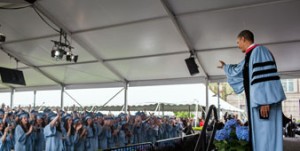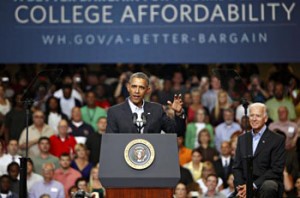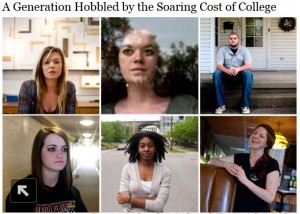 I’ve written in the past about the hysteria surrounding student loans, and the focus in the media about how student loans are the next “bubble.” I recently published an op-ed in the Answer Sheet blog on education of The Washington Post in which I attempted to counter some of the rhetoric with facts about student loans. The piece received a number of comments, most of them critical, so I wrote a response which I expect to be published there sometime later this week.
I’ve written in the past about the hysteria surrounding student loans, and the focus in the media about how student loans are the next “bubble.” I recently published an op-ed in the Answer Sheet blog on education of The Washington Post in which I attempted to counter some of the rhetoric with facts about student loans. The piece received a number of comments, most of them critical, so I wrote a response which I expect to be published there sometime later this week. More recently, Yahoo published a story about one family in Massachusetts who had racked up more than half a million dollars in student loan debt, most of it in Parent PLUS loans, to send the first three of their four children to private colleges. I saw the article when a friend of mine posted it on Facebook, and after reading the story I posted a comment that said, “There is so much wrong with this article, I don’t even know where to start.” He followed up, and asked if I would be willing to explain my response in more detail. I did, and that response received many comments as well. So in the interest of sharing my response more broadly, I am including an edited version of my comments here. These comments will make the most sense if you have read the Yahoo article, so I hope you’ll take the opportunity to do that.
More recently, Yahoo published a story about one family in Massachusetts who had racked up more than half a million dollars in student loan debt, most of it in Parent PLUS loans, to send the first three of their four children to private colleges. I saw the article when a friend of mine posted it on Facebook, and after reading the story I posted a comment that said, “There is so much wrong with this article, I don’t even know where to start.” He followed up, and asked if I would be willing to explain my response in more detail. I did, and that response received many comments as well. So in the interest of sharing my response more broadly, I am including an edited version of my comments here. These comments will make the most sense if you have read the Yahoo article, so I hope you’ll take the opportunity to do that.
Tuition & Student Loans
Pornography to pay for college?
The Internet and mainstream media have been abuzz the last couple of weeks with the story of a first-year student at Duke University who is financing her education by working as an actress in pornographic movies. A Google search today for the terms “duke university porn star tuition” returned 179,000 results. The story evidently surfaced when a fellow student at Duke was watching a video and recognized the woman as someone in one of his classes.
One of the questions framed in much of the media reporting was why a woman would have to resort to being a pornographic film actress to pay for college. In other words, what does this say about the state of tuition prices and financial aid if this young woman felt this was her only option to be able to afford the $60,000 plus price at Duke? As you read more into her story, which I admittedly have done, I would caution observers against drawing too many inferences from the choices she has made.
I’ve written numerous times, both in my scholarly research as well as in this blog, about the role that financial aid plays in promoting college access, particularly for students from groups that have been historically underrepresented in higher education (you can see a couple of blog posts here and here; you can find my scholarly publications and op-eds on my publications page). There is no question that choosing to act in pornographic films to fund one’s education is a novel choice; most college students who work to help fund their education choose more typical jobs, such as work-study jobs on campus or working at a coffee shop. While I am sure this young woman is not the first person to have chosen her selected path, she is apparently the one who has gotten the most publicity for doing so.
President Obama on college cost (Part 3): Pay for student performance
 In my last post on President Obama’s proposals to help control the growth in college costs, I described how the president hopes to influence institutional behavior. Another key part of his proposals is to try to influence student behavior through the federal financial aid system, known as Title IV aid.
In my last post on President Obama’s proposals to help control the growth in college costs, I described how the president hopes to influence institutional behavior. Another key part of his proposals is to try to influence student behavior through the federal financial aid system, known as Title IV aid.
In what is a very brief part of his proposal, but yet may turn out to be one of the most controversial, is this:
Demand Student Responsibility for Academic Performance: To ensure students are making progress toward their degrees, the President will also propose legislation strengthening academic progress requirements of student aid programs, such as requiring students to complete a certain percentage of their classes before receiving continued funding. These changes would encourage students to complete their studies on time, thereby reducing their debt, and will be designed to ensure that disadvantaged students have every opportunity to succeed.
Continue reading “President Obama on college cost (Part 3): Pay for student performance”
President Obama on college costs (Part 2): Pay for institutional performance

One of my favorite phrases when teaching educational policy is “the devil is in the details” (I once wrote an article that used that phrase as the title – it’s chapter 2 of this report). Politicians and policymakers will often issue grand policy proposals that address issues from an altitude of 35,000 feet, and until the details of the new policy are fleshed out it is difficult to determine what the impact will be at ground level.
This is very much the case with President Obama’s announcement last week of a new set of proposals to address the issue of the rising price of college and how Americans pay for it. As I described in my post last week, the president articulated a series of proposals that are very broad in scope and for the most part will require Congressional action in order to implement them. Thus, it is difficult at this point to determine with any degree of certainty what impact the proposals will have on colleges, universities, and students, but I will do my best to analyze them from the information the White House has provided.
Continue reading “President Obama on college costs (Part 2): Pay for institutional performance”
More from President Obama on college costs (Part 1)
 This week President Obama outlined a new series of proposals to help Americans deal with the rising price of college. Addressing college costs has been a priority of the president’s from early on in his first term, but this is probably the most comprehensive set of proposals that have been released at one time. He described them on a two-day, two-state bus tour of college campuses.
This week President Obama outlined a new series of proposals to help Americans deal with the rising price of college. Addressing college costs has been a priority of the president’s from early on in his first term, but this is probably the most comprehensive set of proposals that have been released at one time. He described them on a two-day, two-state bus tour of college campuses.
There is a lot packaged in the president’s proposals, and in the next couple of blog posts I will provide analysis of some of the key pieces. The proposals fall under three main topics:
- Provide incentives for both higher education institutions and students to link financial aid to performance;
- Encourage innovation on the part of colleges and universities to come up with new pathways toward less expensive degrees and provide better information to students and parents; and
- Make loan debt more manageable for those who borrowed to pay for college.
Continue reading “More from President Obama on college costs (Part 1)”
Measuring the return on investment of attending college (Part 1)
Last month I described my testimony at a U.S. House of Representatives hearing on getting better information about college. One of the topics mentioned by a few of the House committee members was the issue of the return on the investment in college as measured by what students are earning today. There has been much interest in getting better data about what graduates of different colleges earn when they enter the labor markets, so that prospective students can get an idea of what the return on their investment in postsecondary education will be.
While measuring the return on investment (ROI) of attending different colleges sounds like a good idea, in reality it is a complex and challenging task. To calculate an ROI, one has to have accurate data on both the value of the investment as well as the value of the return, or the earnings that the investor receives from her investment. While we have lots of data on the cost of attending different colleges, including some data on net prices (as I described in my testimony), we have very little accurate, reliable, and comprehensive data on what the graduates of different colleges earn.
Continue reading “Measuring the return on investment of attending college (Part 1)”
Political theater
 This week I had the opportunity to testify at a hearing of the U.S. Senate Committee on Health, Education, Labor, and Pensions. The hearing was titled “Making College Affordability a Priority: Promising Practices and Strategies.” This committee of the Senate, long chaired by Senator Ted Kennedy of Massachusetts until his death a few years ago, has held a number of hearings on the topic of college affordability in recent years in response to concerns raised in the media, by students and parents, and by policymakers at the state and federal level. The committee is now chaired by Senator Tom Harkin of Iowa, with Mike Enzi of Wyoming the ranking minority member. The hearing came in the middle of a vacation I had planned in New York City, where I was attending a number of Broadway shows. This was certainly a very different type of theater experience.
This week I had the opportunity to testify at a hearing of the U.S. Senate Committee on Health, Education, Labor, and Pensions. The hearing was titled “Making College Affordability a Priority: Promising Practices and Strategies.” This committee of the Senate, long chaired by Senator Ted Kennedy of Massachusetts until his death a few years ago, has held a number of hearings on the topic of college affordability in recent years in response to concerns raised in the media, by students and parents, and by policymakers at the state and federal level. The committee is now chaired by Senator Tom Harkin of Iowa, with Mike Enzi of Wyoming the ranking minority member. The hearing came in the middle of a vacation I had planned in New York City, where I was attending a number of Broadway shows. This was certainly a very different type of theater experience.
This was my first time testifying to a Senate Committee; my three previous trips to Capitol Hill as a witness were on the House side of the Capitol. I was joined on the panel by three college presidents: Steven Leath of Iowa State University, Jim Murdaugh of Tallahassee Community College, and Thomas Snyder of Ivy Tech Community College in Indiana. Also on the panel was Carol Twigg, president of the National Center for Academic Transformation.
The New York Times corrects the truth about student loans
![]() In yesterday’s post, I described how I believe The New York Times in a front-page story misrepresented the state of student loan borrowing. I pointed out that the Times story prominently (above the fold on page one of the Sunday Times) featured the statistic that 94 percent of all graduating bachelor’s degree recipients borrow to pay for higher education, a figure that was far in excess of other data published by the U.S. Department of Education and known to those of us who conduct research on financial aid. After having the figure questioned by a number of people, most prominently economist Sarah Turner of the University of Virginia, the Times finally issued a correction and edited the story. It now states that “About two-thirds of bachelor’s degree recipients borrow money to attend college, either from the government or private lenders, according to a Department of Education survey of 2007-8 graduates; the total number of borrowers is most likely higher since the survey does not track borrowing from family members.”
In yesterday’s post, I described how I believe The New York Times in a front-page story misrepresented the state of student loan borrowing. I pointed out that the Times story prominently (above the fold on page one of the Sunday Times) featured the statistic that 94 percent of all graduating bachelor’s degree recipients borrow to pay for higher education, a figure that was far in excess of other data published by the U.S. Department of Education and known to those of us who conduct research on financial aid. After having the figure questioned by a number of people, most prominently economist Sarah Turner of the University of Virginia, the Times finally issued a correction and edited the story. It now states that “About two-thirds of bachelor’s degree recipients borrow money to attend college, either from the government or private lenders, according to a Department of Education survey of 2007-8 graduates; the total number of borrowers is most likely higher since the survey does not track borrowing from family members.”
Continue reading “The New York Times corrects the truth about student loans”
The truth about student loans

The New York Times is currently running a series on student loans, a topic that has been at the forefront of both the media and the general public for some time now. There has been widespread publicity (here’s just one recent example from USA Today) regarding the fact that student loan balances now exceed $1 trillion, an amount in excess of the balances of either consumer credit card debt or automobile loans.
The first installment of the Times series ran in a most visible location: above the fold in the Sunday paper (the headline and image above is from the web version of the article).